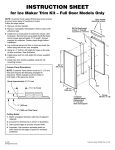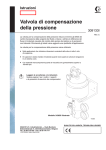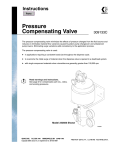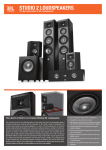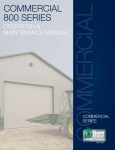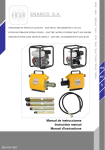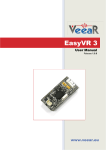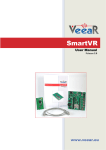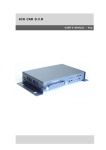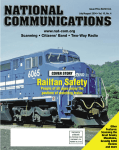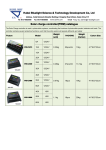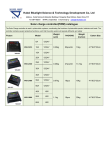Download Haas Pan O&M Manual - Crawford Garage Doors
Transcript
OPERATION & MAINTENANCE MANUAL COMMERCIAL COMMERCIAL RIBBED STEEL COMMERCIAL SERIES 24 C2011 in white 2” Thick Optional Insulation C2011L / C2011S / C2411 / C2470 / C2480 / C2411L / C2470L / C2480L / C2411S / C2480S / C2460 / C2460L / C2511 /C2511L / C2511S ///////////////////////////////////////////////////// Strength and Value The Haas Commercial Ribbed Steel Series doors are a value-based product that offers the strength of steel in four panel and color choices. Energy efficient insulation panels are an upgradable option available on all models. Ribbed steel doors are the ideal choice when economy is the C2411 in sandstone prime consideration but a high quality, beautifully crafted product is still a necessity. C2411 in sandstone 25 Ribbed Steel / 2” thick / optional insulation COMMERCIAL RIBBED STEEL Almond OPTIONS COLOR OPTIONS Polar White Ribbed Steel Available Options Optional Exhaust Port (interior view) 2” or 3” Track Double Steel End Stiles Exhaust Port Cam Safety Device Spring Bumpers Chain Hoist High Cycle Springs Wind Load Rating Glazing (lites) High Cycle Rollers Aluminum Full View Section Keyed Lock Sandstone Brown C2411 in sandstone 26 C2411 in sandstone RIBBED STEEL QUICK GUIDE Smooth Ribbed Steel Models C2011, C2011L, C2011S, C2511, C2511L, C2511S White Only Models C2411, C2411L, C2411S White, Brown, Sandstone Window Options: p 31 Model Carriage House Woodgrain Panel Models C2460/C2460L White, Brown, Sandstone, Almond Window Options: p 31 Door Thickness R-Value* Max. Door Size Width Height Ranch Woodgrain Panel Models C2470, C2470L White, Brown, Sandstone, Almond Window Options: p 31 Ribbed Steel / 2” thick / optional insulation DOOR PANELS Raised Woodgrain Panel Models C2480, C2480L, C2480S White, Brown, Sandstone, Almond Window Options: p 30 Section Skins End Stile Type Inside Outside Insulation Type C2011 2” N/A 30’-2” 20’-0” Boxed Steel N/A 20 GA Ribbed Steel None C2011L 2” 7.45 30’-2” 20’-0” Boxed Steel Laminate Backer 20 GA Ribbed Steel Inserted Polystyrene Panels C2011S 2” 7.45 24’2” 20’-0” Boxed Steel Steel Backer 20 GA Ribbed Steel Inserted Polystyrene Panels C2411 2” N/A 30’-2” 20’-0” Boxed Steel N/A 24 GA Ribbed Steel None C2470 2” N/A 18’-2” 16’-0” Boxed Steel N/A 24 GA Ranch Panel Woodgrain Steel None C2480 2” N/A 24’-2” 16’-0” Boxed Steel N/A 24 GA Raised Panel Woodgrain Steel None C2411L 2” 7.45 30’-2” 20’-0” Boxed Steel Laminate Backer 24 GA Ribbed Steel Inserted Polystyrene Panels C2470L 2” 7.45 18’-2” 16’-0” Boxed Steel Laminate Backer 24 GA Ranch Panel Woodgrain Steel Inserted Polystyrene Panels C2480L 2” 7.45 24’-2” 16’-0” Boxed Steel Laminate Backer 24 GA Raised Panel Woodgrain Steel Inserted Polystyrene Panels C2411S 2” 7.45 24’-2” 18’-0” Boxed Steel Steel Backer 24 GA Ribbed Steel Inserted Polystyrene Panels C2480S 2” 7.45 24’-2” 18’-0” Boxed Steel Steel Backer 24 GA Raised Panel Woodgrain Steel Inserted Polystyrene Panels C2460 2” N/A 18’-2” 16’-0” Boxed Steel N/A 24 GA Carriage House Panel Woodgrain Steel None C2460L 2” 7.45 18’-2” 16’-0” Boxed Steel Laminate Backer 24 GA Carriage House Panel Woodgrain Steel Inserted Polystyrene Panels C2511 2” N/A 16’-2” 16’-0” Boxed Steel N/A 24 GA Nominal Ribbed Steel None C2511L 2” 7.45 16’-2” 16’-0” Boxed Steel Laminate Backer 24 GA Nominal Ribbed Steel Inserted Polystyrene Panels C2511S 2” 7.45 16’-2” 16’-0” Boxed Steel Steel Backer 24 GA Nominal Ribbed Steel Inserted Polystyrene Panels *calculated R-Value 27 Installation & Maintenance Service Manual For Commercial Steel Doors 320 Sycamore Street Wauseon, OH 43567 www.haasdoor.com Rev. 5/12 Read Instructions Thoroughly Before Starting Installation ©2012 Haas Door Company 1 Haas Door Commercial Instruction Manual OPENING PREPARATION Note : All framing materials must be provided by building contractor or installer. Figure 2 Some large doors may require additional pad or pads located off center to accommodate auxiliary bearings. W S W S All vertical jambs and pads regardless of type, must extend to top of headroom requirement. W W Opening Height B Steel Channel S 2X6 Wood Jambs Opening Width Section “W” Interior Elevation S 3” Min. Steel Jambs Section “S” STEP 1 INSTALLATION OF DOOR Check the size of door to be sure it is the same size as opening. Inspect the track and determine if you have reverse angle or bracket mount tracks. Note: bracket mount has individual j-brackets to attach track to jamb, reverse angle has a continuous angle to attach track to jamb. Note: if door is supplied with reverse angle. The door should be 2” wider than opening. J Center Hinge Bottom Section G End Hinge see Figure 6 on page 4 for correct hinge numbers Center Stile Weatherstrip Figure 3 STEP 2 Roller H Cable Bottom Bracket Drill a 3 /16” diameter hole for this screw Attach hardware to bottom section with 1/4” x 3/4” hex head sheet metal screws (see Figure 3). If door requires struts (ubars) see Figure 8 on page 4. 2 © 2012 Haas Door Company Rev. 5/12 Haas Door Commercial Instruction Manual INSTALLATION OF VERTICAL TRACKS STEP 3 Position bottom section in center of the opening, allowing equal distance from each side of the opening. STEP 4 Position left hand track over rollers as shown in Figure 4. Space track 1/2” from door as shown. Before attaching vertical track angle or brackets to jambs it must be plumb and parallel to door and raised to match leveling of bottom door section. Attach vertical track angles to jambs by welding or by using 1/4” self drilling screws on steel jambs or 5/16" x 1 1/ 2” hex head lag screws on wood jambs. If mounting directly to masonry, anchors are not supplied. Repeat above step for right hand track. (Note: Both tracks must be parallel for proper operation) Insert rollers into end hinges. Hook rollers into vertical track and swing end hinges onto door section as shown at left. Secure with fasteners provided. STEP 5 Place #2 section on top of bottom section. Note: if door is supplied with cylinder lock, use section with lock holes punched or drilled in it (see Step 19 on page 8). Attach hinges and rollers as shown in Figure 5. See hinge schedule Figure 6 on page 4 for correct placement of numbered hinges. If inside lock is supplied, see Figure 7. Rev. 5/12 © 2012 Haas Door Company 3 Haas Door Commercial Instruction Manual HINGE SCHEDULE STEP 6 Complete the remainder of the sections at this time. Top door section should only be installed after horizontal track or full vertical track has been installed. Note: if door is supplied with full view aluminum section(s), attach hinges with 1/4” self drilling screws provided. STEP 7 SLIDE BOLT LOCK The inside lock is installed on the end stile of the second section so the slide bolt rests against the top of one of the rectangular engaging slots in the vertical track (see Figure 7). If door is supplied with cylinder lock, see page 8. STEP 8 U-BAR INSTALLATION All trusses (u-bars) except top section truss are attached with tech screws below hinges as shown in Figure 8. Top section truss is located directly above the top roller brackets, secured at the ends with tech screws. Secure all trusses to center stiles through existing holes utilizing tech screws. Note: Doors over 14’-2” wide require one truss per section. STEP 9 STANDARD LIFT TRACK Attach bearing brackets to the horizontal angles with 3/8” x 3/4” bolts & nuts. Form rope loops to a convenient overhead structural member & insert horizontal tracks through them, then attach bottom of the curved portions of track to the top of the vertical tracks at the splice brackets with 1/4” x 5/8” truss head machine screws & nuts. Head of machine screws should be to inside of the track (see Figure 9). Using a level, strike a plumb line from the inside of the splice bracket to the inside of the horizontal angle on each side. Place outside edges of bearing brackets against the plumb lines and attach brackets securely to the wall (see Figure 9). 4 © 2012 Haas Door Company Rev. 5/12 Haas Door Commercial Instruction Manual STEP 9a HI-LIFT TRACK STEP 9b VERTICAL LIFT TRACK Connect vertical hi-lift track to top of existing vertical track with 1/4”x 5/8” truss head machine screws. Set track plumb and fasten to jamb in the same manner as the vertical track previously installed in Step 4. Attach bearing brackets to the horizontal angles with 3/8” x 3/4” bolts & nuts. Form rope loops to a convenient overhead structural member and insert horizontal tracks through them, then attach bottom of the curved portions of track to the top of the vertical tracks at the splice brackets with 1/4” x 5/8” truss head machine screws and nuts. Head of machine srews should be to inside of the track (see Figure 9a). Using a level, strike a plumb line from the inside ot the splice bracket to the inside of the horizontal angle on each side. Place outside edges of bearing brackets against the plumb lines and attach brackets securely to the wall (see Figure 9a). Place upper vertical track on top of lower vertical track. Plumb track and attach to wall in same manner as lower vertical tracks. Heads of machine screws should be to inside of the tracks as shown in Figure 9b. (Jamb fasteners must be installed with no more than 48” between each fastener.) Now set bearing brackets against the plumb lines and attach brackets securely to the track and wall. STEP 10 HORIZONTAL TRACK SUPPORT STEP 11 TOP BRACKETS Replace temporary support hangers with steel support angle (not supplied). Install sway braces only after checking the horizontal track with a tape measure or spacing bar to verify that they are parallel. Important: steel support or other means must be strong enough to support full door weight and must be attached to a structurally sound member. Note: a center horizontal track support is required for doors larger than 12’-1” in height (see Figure 1 Item A on page 1). Rev. 5/12 Place top section in position. With rollers inserted in the sleeves of top roller brackets, bolt brackets to section through holes provided, utilizing self-tapping screws. Adjust bracket slide so top section is perfectly vertical and tighten adjusting bolt securely. Attach top leaves of hinges from the preceding section. Check tracks for proper clearance and permanently secure all fasteners. © 2012 Haas Door Company 5 Haas Door Commercial Instruction Manual WARNING: Installing torsion springs can be a dangerous procedure and should only be performed by qualified door service personnel. Do not attempt installation without proper tools and until reading and understanding the following instructions. STEP 12 COUNTERBALANCE INSTALLATION Determine what type of spring assembly you have as shown in figures 12, 13, 14 or 15. STEP 13 Place the center support bracket and the bearing on the axles as shown in Figure 16 (bearing sits inside spring fitting). Bolt spring fitting(s) to center support bracket (see Figure 16 or 17) using 3/8” dia. x 1 1/2” hex head bolts. Slide a cable drum on both ends of shaft. Be sure correct hand drum is used (see Figures 12 thru 15). Slide bearing on each shaft end if not already bolted to track. 6 © 2012 Haas Door Company Rev. 5/12 Haas Door Commercial Instruction Manual STEP 14 Raise the shaft assembly over the door. If 2 piece shaft with coupling is supplied, raise half the total shaft at a time. Rest the end(s) of shaft on the horizontal track angle. See Figure 19 For coupling installation. STEP 15 Locate and attach spring bearing plates/center support bracket to mountlng pads (not supplied). See Figure 2 for wood or steel frame (jambs) . Mount spring brackets to structural member of building of sufficient size to withstand spring(s) torque. When mounting springs on pads, keep in mind that springs grow in length when wound. Allow at least 5” space between spring fitting and cable drum. If mounting the center support bracket to wood, use (2) 5/16” x 1 5/8” long hex head lags for each bracket. For steel jambs use (2) 3/8” x 1 1/2” hex head bolts. If mountlng directly to concrete use (2) 5/16” dia thru bolts or threaded rods (not supplied). STEP 16 ATTACHING THE CABLES Thread each cable between the axle and wall. Then insert each cable into the entry slot of each drum. Wind the excess cable on the drum, then slide the drum against the bearing plate and tighten the two set screws securing the drum to the shaft. Clamp a set of locking pliers with the jaws locked onto the shaft and the other end against the wall so that cable tension 0n the drum is taut (no slack) and the shaft locked. Secure the remaining drum making sure both cables have equal tension and are taut (see Figure 20). If axle is a solid shaft use a 1/4” key for both drums. STEP #17 Before going to Step 18. Be sure door is in locked position. If no lock is supplied, place a clamp in both tracks of door directly above a roller to make sure door can not be raised at this tlme. STEP # 18 WINDING SPRING (see Figure 21) Note: garage door springs can cause serious injury if not handled properly. Before winding the springs, make sure the lock is engaged in the “locked” position. This will prevent the door from raising up by itself in the event the springs are over wound or are too strong . Use two cold rolled steel rods approximately 18” long and the same diameter as the holes in the winding cones (winding rods not furnished) 1/2” dia. for 1 3/4” & 2 5/8” springs and 5/8” dia. for larger springs. Do not use undersized rods or other tools to wind springs. For your safety, position yourself on a sturdy ladder so that winding cone is either to your right or to your left. Never stand directly in front of winding cones or winding bars. With one hand, insert one winding rod all the way into the hole of the winding cone and wind the spring up one-quarter turn. With your other hand, insert the second winding bar into the next hole, remove the upper winding bar and then take another one-quarter turn. Proceed in this manner until you have made all the required number of turns. The number of turns are indicated on the spring tag attached to the spring assembly. For example, if the tag says “wind spring 7 turns, 7 x 4 = 28 one-quarter turns are required to balance. Note: each complete turn will cause the chalk line to make one spiral. After the requred number of 1/4 turns have been made, tighten both set screws in the winding cone to secure it to the shaft before removing the winding bars. Repeat this procedure for each spring, then locking pliers can be removed. Attach one red warning label to spring. Rev. 5/12 © 2012 Haas Door Company 7 Haas Door Commercial Instruction Manual STEP 19 CYLINDER LOCK INSTALLATION If lock cylinder is supplied, install in lock section as shown in the exploded view (see Figure 22). STEP #20 LIFT HANDLES Install lift handle(s) on bottom section with 1/4” - 20 nuts and bolts supplied (as shown in fig. # 23). MAINTENANCE & CAUTIONS Recommended Service: lubricate rollers with a light oil as required. Check and tighten all nuts, bolts and screws annually. (This may be required more frequently for high usage doors.) Haas Door recommends servicing any part of the counterbalance system including springs, drums cables, bearing brackets, and bottom corner brackets where cable is attached be performed by qualified door service personnel only (see notice below). Important Safety Notice: Operate door only when properly adjusted and free of obstructions. Door is under extreme spring tension. Repairs and adjustments, especially to cables and spring assembly, can be hazardous and should be performed by qualifled door service personnel only. Do not permit children to play with garage door or electric controls. If door is now, or later becomes, electrically operated, pull down rope must be removed. Avoid standing in open doorway or walking thru doorway while electrically operated door is moving. Should door become hard to operate or completely inoperative, it is recommended that a qualified door agency be contacted. The notice above has been approved and recommended by the National Association of Garage Door Manufacturers (NAGDM). 8 © 2012 Haas Door Company Rev. 5/12 C2010, C2400 & C2500 Series (formerly 220, 224 & 224E Series) STEEL COMMERCIAL GARAG E DOORS Haas Door Company warrants its commercial models C2010, C2400 & C2500 series (formerly 220, 224 & 224E series) steel garage door sections to be free from defects in workmanship and material for a period of one (1) year from date of installation. This Warranty applies only to steel garage door sections manufactured by Haas Door Company and components manufactured or supplied by Haas Door Company. The warranty excludes: (1) Sections and/or component parts which have been damaged due to misuse; (2) Sections and/or components which have been improperly installed, maintained or operated; (3) Sections and/or components that have been damaged due to accident; (4) Sections and/or components that have been damaged due to exposure to corrosive fumes/chemicals, alkaline cleaning agents, condensation or fire; (5) Performance of coatings used to finish the garage door sections; (6) Repair and/or replacement labor charges, including travel cost; (7) Damages resulting from other causes beyond the manufacturers control. In the event any defect is claimed during the warranty periods, a claim in writing must be submitted to Haas Door Company, directed through an authorized Haas Door Company dealer or installer. This claim must be submitted within fifteen (15) days of the discovery of the suspected defect. The door and all components must be available for inspection by an authorized Haas Door Company representative. Upon verification of a manufacturing defect, Haas Door Company will provide repair or replacement part(s) at its option. THE MANUFACTURER SHALL NOT BE RESPONSIBLE FOR ANY INCIDENTAL OR CONSEQUENTIAL DAMAGES ARISING OUT OF ANY BREACH OF THIS EXPRESS LIMITED WARRANTY, including but not limited to any damage to buildings, other property or for any injuries or damages sustained by any person whomsoever, or the recovery of any direct or indirect costs such as shipping, travel, lost time, installation labor charges, paint or painting, cleaning, repair, or other building materials. This warranty gives you specific legal rights and you may also have other rights that may vary from state to state. Haas Door Company does not authorize anyone to change or modify the above warranties in any respect. ANY IMPLIED WARRANTY OR MERCHANTABILITY OR FITNESS FOR A PARTICULAR PURPOSE APPLICABLE TO THE COMMERCIAL MODEL(S) OF STEEL OVERHEAD GARAGE DOORS IS LIMITED IN DURATION TO THE DURATION OF THE HAAS DOOR COMPANY WRITTEN WARRANTY SET FORTH ABOVE AND NEITHER HAAS DOOR COMPANY NOR ANY AUTHORIZED SELLING DEALER SHALL BE LIABLE FOR LOSS OF TIME, INCONVENIENCE, COMMERCIAL LOSS, OR OTHER CONSEQUENTIAL OR INCIDENTAL DAMAGES. Some states do not allow limitations on how long an implied warranty will last or the exclusion or limitation of incidental or consequential damages, particularly in consumer transactions, so the above limitations or exclusions may not apply to you. ----- THIS WARRANTY IS NOT TRANSFERABLE ----- 2013 Haas Door Company Effective: June 4, 2003 Revised: March 22, 2013














